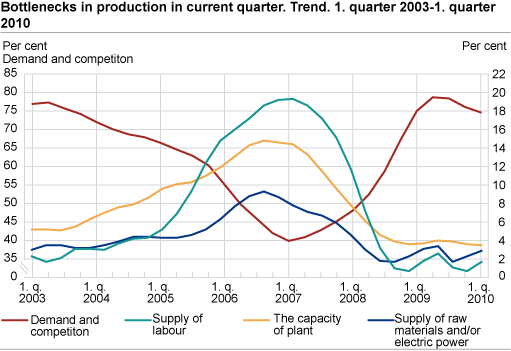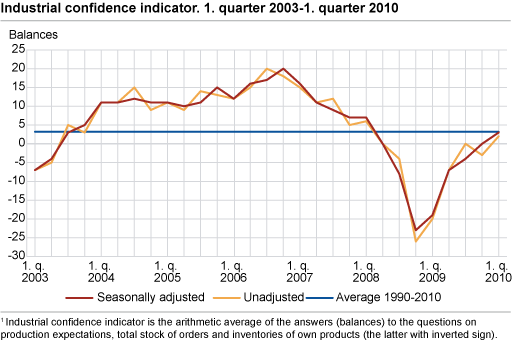Content
Published:
This is an archived release.
Prospects of moderate growth in output
Norwegian industrial managers report that the decline in total output came to a halt in the first quarter. Production is now expected to rise.
According to the business tendency survey, the Norwegian manufacturing industry experienced a stabilisation in output after six quarters of decline. Total employment continued to fall, but the downward trend shows signs of levelling out. A lack of new orders for capital goods caused total stocks to decline and had a negative effect on market prices. Poor demand and fierce competition continued to play a major role in restricting production.
The number of working months covered by the current stock of orders was close to the historic average for the manufacturing industry. This is significantly less than the corresponding figure for 2009. Poor demand for ships, boats and oil platforms partly explains this development. Average capacity utilisation is estimated at 76.9 per cent. International comparisons of average capacity utilisation are available from EUROSTAT .
The indicator covering the general short-term outlook (Q2 2010) is changing from neutral to positive. Prospects of improved conditions for producers of intermediate goods and consumer goods explain this development. The industrial confidence indicator is estimated at 3 (seasonally-adjusted net figure) in the first quarter. The result indicates a modest improvement in the business cycle. International comparisons of the industrial confidence indicator are available from EUROSTAT (EU), the Swedish National Institute of Economic Research (Sweden) and Statistics Denmark .
Improved conditions for producers of intermediate goods
Sectors producing intermediate goods (wood and wood products, paper and paper products, non-metallic mineral products, basic metals etc.) experienced modest growth in output. Meanwhile, employment continued to fall. An increase in new orders from home and export markets caused total stocks of orders to rise. Market prices, however, continued to fall. The number of working months covered by the current stock of orders lies close to the historic average for the industries in question. Average capacity utilisation is estimated at 77.2 per cent.
The general short-term outlook is considered to be positive. A decline in stocks of finished goods and prospects of a rise in new orders explains this result.
Low capacity utilisation among producers of capital goods
Sectors producing capital goods (machinery and equipment, ships, boats and oil platforms etc.) experienced a further reduction in output and employment. A lack of new orders caused total stocks to fall, and the poor demand was reflected by a decline in market prices. The number of working months covered by the current stock of orders lies close to the historic average. However, average capacity utilisation is estimated to be as low as 78.1 per cent. Investments in excess capacity in the years prior to the international financial crisis partly explain this result.
The general short-term outlook is still considered to be poor, but somewhat fewer share this view. The decline in new orders from domestic markets is expected to come to a halt in the second quarter.
Improved demand for consumer goods
Sectors producing consumer goods (food products, printing and reproduction, basic pharmaceuticals, furniture etc.) experienced growth in output and employment. Improved demand from domestic markets was the main reason for this development. Home market prices were more or less unchanged in the first quarter, while export prices continued to fall. Average capacity utilisation is estimated at 75.3 per cent. This is well below the historic average for the industries in question.
The general short-term outlook is considered to be positive. Expectations of a further growth in output and demand explain this result.
| Industry | Prospects | Background | |||||||||||||||||||||||||||||||||||||||||||||||||||||||||||||||||||||||||||||
|---|---|---|---|---|---|---|---|---|---|---|---|---|---|---|---|---|---|---|---|---|---|---|---|---|---|---|---|---|---|---|---|---|---|---|---|---|---|---|---|---|---|---|---|---|---|---|---|---|---|---|---|---|---|---|---|---|---|---|---|---|---|---|---|---|---|---|---|---|---|---|---|---|---|---|---|---|---|---|---|
| Food, beverages and tobacco | + | Higher levels of production, capacity utilisation and employment in Q1. Increase in demand and market prices from the domestic market. Demand from the export market is more or less unchanged. Many managers judge the general outlook for Q2 as better. Output, demand and market prices are expected to increase n the forthcoming quarter. | |||||||||||||||||||||||||||||||||||||||||||||||||||||||||||||||||||||||||||||
| Wood and wood products | ++ | Higher levels of production, capacity utilisation and employment in Q1. Rise in new orders from the domestic market, and more or less unchanged level of new orders from the export market. Growth in market prices. Many managers consider the general outlook for the forthcoming quarter as positive. Expectations of growth in output, new orders and market prices. | |||||||||||||||||||||||||||||||||||||||||||||||||||||||||||||||||||||||||||||
| Paper and paper products | +(-) | A large number of managers report higher levels of production and capacity utilisation. The level of employment is reduced. Increase in new orders, both from the domestic and export market. Decline in export prices. The general outlook for Q2 is judged as better. Output and market prices are expected to increase. Employment is expected to decline. | |||||||||||||||||||||||||||||||||||||||||||||||||||||||||||||||||||||||||||||
| Basic chemicals | + | Higher levels of production and capacity utilisation. Moderate growth in the level of employment. Many managers report rise in the level of new orders. Growth in domestic market prices, while export prices are reduced. Many managers consider the general outlook as better, and output, employment, new orders and market prices are expected to increase in Q2. | |||||||||||||||||||||||||||||||||||||||||||||||||||||||||||||||||||||||||||||
| Non-ferrous metals | ++ | Further growth in output and capacity utilisation. Employment is reduced. The level of new orders has increased, both in the domestic and export market. Higher market prices. Shortage of raw materials and/or electric power is a limiting factor for production. Many managers judge the general outlook for Q2 as positive. The levels of production, new orders and market prices are expected to increase. Employment is expected to decline. | |||||||||||||||||||||||||||||||||||||||||||||||||||||||||||||||||||||||||||||
| Fabricated metal products | -- | Many managers report lower levels of production, capacity utilisation and employment. Reduced level of new orders and market prices. Poor demand and fierce competition are limiting factors for production. General outlook for Q2 is considered worse. Output, new orders and market prices are expected to decline. | |||||||||||||||||||||||||||||||||||||||||||||||||||||||||||||||||||||||||||||
| Computer and electrical equipment | -- | Many managers report lower levels of production and employment. Decline in capacity utilisation. Reduced levels of new orders and market prices. Poor demand and fierce competition are limiting factors for production. The general outlook for the forth coming quarter is judged as negative. Output, employment and market prices are expected to decline. | |||||||||||||||||||||||||||||||||||||||||||||||||||||||||||||||||||||||||||||
| Machinery and equipment | -- | Output, capacity utilisation and employment are reduced in Q1. Decline in new orders and market prices. Poor demand and fierce competition are limiting factors for production. General outlook for Q2 is considered worse. Reduced levels of production and market prices are expected. | |||||||||||||||||||||||||||||||||||||||||||||||||||||||||||||||||||||||||||||
| Ships, boats and oil platforms | -- | Reduced activity and lower level of employment. The stock of orders is reduced as a consequence of lack of new orders. Decline in market prices. Poor demand and fierce competition are limiting factors for production. Many managers judge the general outlook as worse. Further reductions in output, employment and market prices are expected. The reduction in new orders from the domestic market is expected to slow down. | |||||||||||||||||||||||||||||||||||||||||||||||||||||||||||||||||||||||||||||
| Repair, installation of machinery | -- | Reduced activity and lower level of employment in Q1. Decline in new orders and market prices. The general outlook for Q2 is judged as negative. The levels of production, employment and market prices are expected to decline. The reduction in new orders from the domestic market is expected to slow down. | |||||||||||||||||||||||||||||||||||||||||||||||||||||||||||||||||||||||||||||
| The column for Prospects shows an overall evaluation of the present situation and expected short-term developments using the symbols + and -. The following codes and constellations are used: |
++
+ ~ - -- +(-) +/- |
Very good
Good Stable Poor Very poor Good, but with certain negative indications A situation where the + and - factors even out. |
|||||||||||||||||||||||||||||||||||||||||||||||||||||||||||||||||||||||||||||
Industrial confidence indicator (ICI)The indicator is the arithmetic average of the answers (balances) to the questions on production expectations, total stock of orders and inventories of own products (the latter with inverted sign). The indicator is a guide to the level of industrial production because:
TimelinessThe survey data was collected in the period between 10 March 2010 and 20 April 2010. |
Additional information
The statistics provide current data on the business cycle for manufacturing, mining and quarrying by collecting business leaders’ assessments of the economic situation and the short term outlook.
Contact
-
Edvard Andreassen
E-mail: edvard.andreassen@ssb.no
tel.: (+47) 40 90 23 32
-
Ståle Mæland
E-mail: stale.maeland@ssb.no
tel.: (+47) 95 05 98 88


